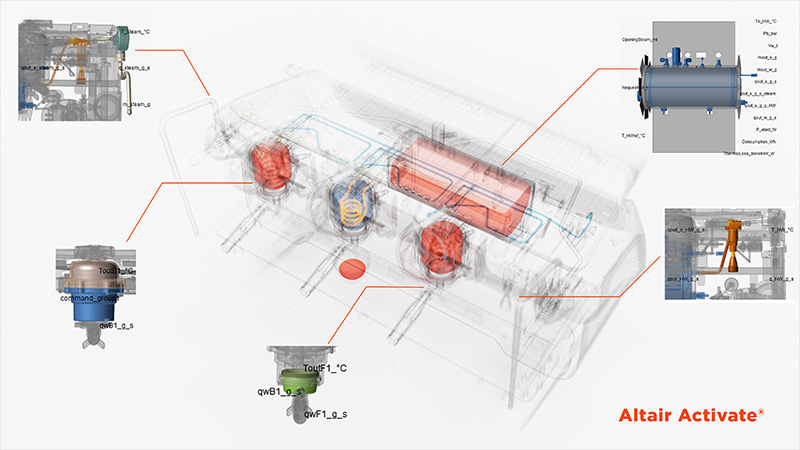Digital Debunking: Can the Perfect Espresso Be Made with Non-Traditional Methods?
As the weather cools around Altair’s Troy, Mich. headquarters, we can’t help but appreciate a good cup of coffee to warm the body and mind. And wouldn’t you know it? In the U.S., National Espresso Day also falls on November 23! Let’s just say we’ve had coffee on our minds for a while, especially one special type of brew.
Since its discovery in the 15th century, coffee has always been something over which people have met, exchanged experiences, closed deals, and made friendships. Its long history is punctuated by the discovery of new varieties and new ways of preparation, and above all by the myriad of extraction methods and technologies, which various cultures and societies have developed to obtain the precious elixir.
Among these techniques, espresso holds the status as one of the finest, most widespread methods in the world. It’s also one of the most technologically complex. Fans of espresso are passionate and loyal; so passionate that its perfection has taken on mythical proportions. Espresso fans all have one ultimate goal: to obtain the perfect espresso – the mythical “golden shot.”
The Basics of Espresso
Espresso technology was born in Italy at the dawn of the 20th century, between Turin and Milan. It was developed to satisfy the ever-growing demand for coffee in the city centers’ crowded cafes. It was based on the power of steam and pressure, inspired by the huge and powerful steam engines that powered the era’s defining technology. Specifically, espresso aimed to accelerate the extraction process and obtain a new, concentrated coffee-based drink with a stronger flavor and high caffeine content – perfect for giving people a tasty, powerful kick to start their day.
But no espresso would exist without a fundamental figure: the barista. The barista is the invaluable human factor in espresso making, capable of tailoring the extraction process to the conditions of the environment, acting on the grinding, and keeping temperature, pressure, and humidity within optimal levels. In many ways, they’re like orchestra conductors. As such, with great power comes great responsibility. A bad shot of espresso can set a negative tone for the rest of someone’s day!
Perfecting the Espresso
As much as the perfect shot of espresso is an art, it’s also a science. There’s a lot of data that can help brew a great batch of espresso. To start, brewers need approximately 7-10 grams of finely ground, premier coffee beans. Water temperature needs to be around 195-205 F (90.5-96.1 C). With the help of up to 9 bars (135 pounds per square inch, or 930 kilopascals) of pressure, the water is pushed through the precious powder to be transformed into a creamy, opaque liquid in no more than 20-30 seconds. If done correctly, this process gets you 30 milliliters of pleasure.
Since the first espresso, the world has transformed; we’ve moved from the steam era to the digital era and everything in between. However, the espresso machine (and its barista) still harken back to a bygone era: water, heat, steam energy, intense pressure, and quality coffee are still all that’s needed to brew a great espresso. But though espresso may seem simple, it’s not all straightforward. After all, espresso takes energy to brew – and the world drinks a lot of espresso. In an age where low energy consumption and energy efficiency are vital to a better future, the world requires espresso machines that meet today’s environmental standards.
Espresso and Simulation: An Unlikely Alliance
A professional espresso machine can consume tens of thousands of watts of energy just to turn on. That’s to say nothing of its operation!
So how can we bring these machines and their baristas, so beholden tradition and artisanal experience, into the age of data and environmental awareness without sacrificing the perfect espresso? Can you truly only make a perfect espresso using traditional methods? Or can new, cutting-edge machines blend art and science for the modern era?
Altair and Gruppo Cimbali, a leader in the production of professional espresso machines, found that it’s the latter. Enabling it all is digital twin technology. Thanks to Altair technology, Gruppo Cimbali has built a virtual twin of the base systems of one of its premier professional-grade espresso machines, including all the key components that are essential in brew to a perfect espresso shot.

Within Altair® Twin Activate™, all the subsystems are orchestrated and put to work making thousands of digital espressos virtually. Twin Activate operates the machine without having to build physical prototypes, thus saving time, resources, and most of all, energy.
Multiple runs with the digital twin effortlessly enabled Gruppo Cimbali engineers to extract data and insights about what once was a purely analog process. These digital insights helped Gruppo Cimbali create a final prototype that took them 30% less time than before. By leveraging data from Altair Activate, Gruppo Cimbali was also able to design a new generation of machines that are 20% more energy efficient.

Of course, the barista remains a crucial factor behind every espresso – as in all things, a personal touch goes a long way. But in this digital era, Twin Activate and its digital twin technology can give baristas more insights, more data, and more efficiency than ever before.
So, what happens when two “maestros” of their trade join forces? A golden shot – every time. Learn more about Altair and Gruppo Cimbali's collaboration in this customer story.
Learn more about Altair’s digital twin solutions at https://altair.com/digital-twin.





